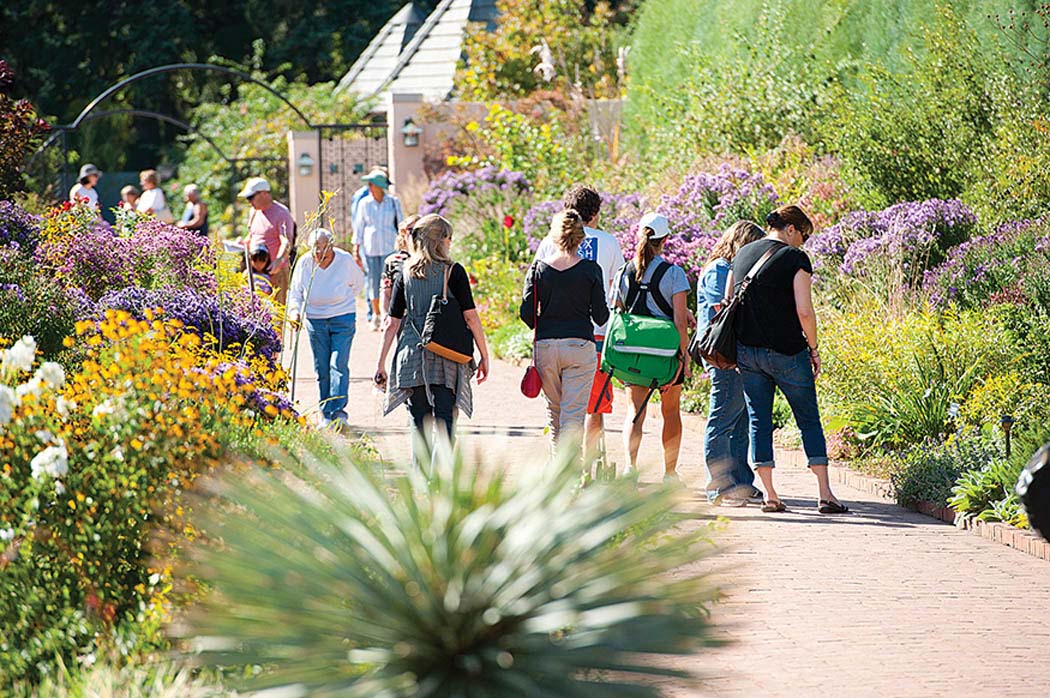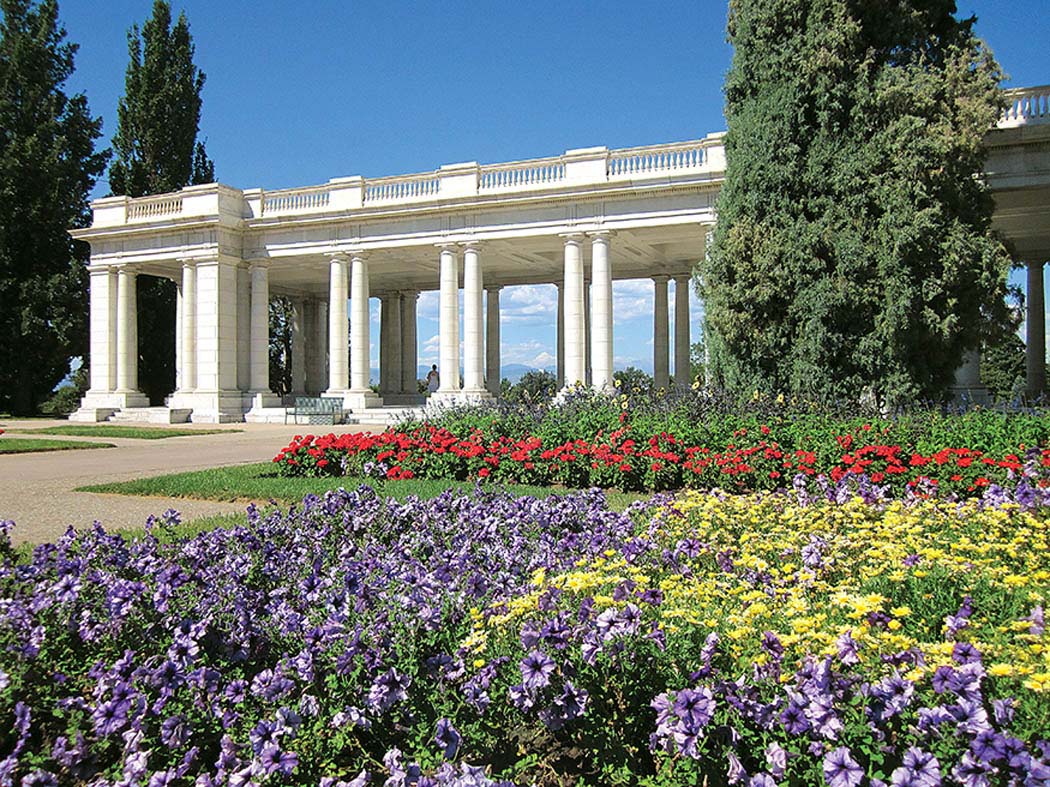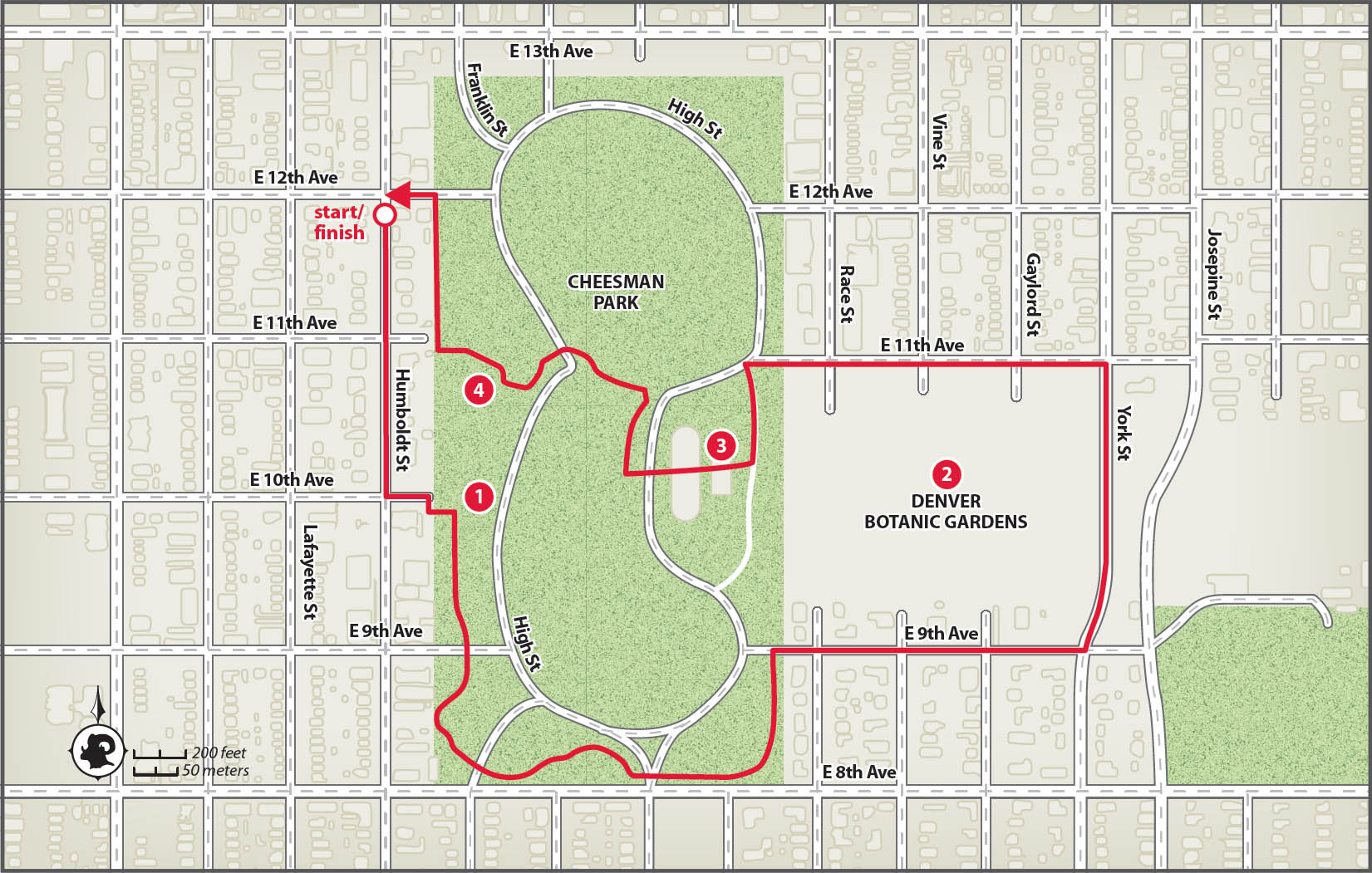

Denver Botanic Gardens photographed by Scott Dressel-Marti/Visit Denver
BOUNDARIES: 12th Ave., Humboldt St., 8th Ave., York St., 11th Ave.
DISTANCE: 1.75 miles
DIFFICULTY: Easy
PARKING: Free parking along Humboldt St. and 12th Ave. and within Cheesman Park, as well as in the parking garage at Denver Botanic Gardens
PUBLIC TRANSIT: From downtown, take RTD route 10 bus to York St. in front of Denver Botanic Gardens; Denver B-cycle (denverbcycle.com) has a bicycle rental station in front of the gardens.
The first two blocks of this walk are along Denver’s first designated residential historic district. The owners of these stately mansions sought the designation as more and more homes were replaced by the high-rise apartment buildings you will see in another part of this walk. Not only were exquisite homes demolished but the taller buildings also obliterated the mountain views from the individual homes. Despite the fact that Cheesman Park was the site of Denver’s first cemetery, people saw the potential beauty of the area and began building some of these homes before there was actually a park next door. The eastern side of the old cemetery was converted to the Denver Botanic Gardens in 1958 and is worth walking around in any season to explore its indoor and outdoor gardens.
Note: Cars share the roads with pedestrians and cyclists within Cheesman Park.
Walk Description
Begin the walk at 12th Avenue and Humboldt Street and walk south on Humboldt Street. It does not matter which side of the street you choose to walk on as you admire the splendid historic homes and shady sidewalks. These next two blocks are also informally called “Humboldt Island” because of the concentration of preserved historic homes.
Cross 11th Avenue as you continue south on Humboldt Street. The house at 1075 Humboldt Street was built in 1906 and served as the governor’s residence from 1922 to 1924 for then governor William Sweet. Presidents Teddy Roosevelt and William Howard Taft were guests and public speakers of the house at 1061 Humboldt Street when Harry Tammen, a cofounder of the Denver Post, resided here. The house at 1022 Humboldt Street was built with 46 rooms, including 9 bathrooms and a basement pool, in 1907.
Cross 10th Avenue and turn left to enter  Cheesman Park, an 80-acre oasis in the middle of the city. Take a right on the gravel path and continue walking south. (There is a paved path for cyclists that at times runs parallel to this footpath.) Despite joggers, cyclists, and a road that cuts through the park, this stroll is fairly peaceful and often shady in summer. Cheesman Park is considered Capitol Hill’s park as it’s the largest in this neighborhood, and it’s also associated with the local LGBT scene. The annual PrideFest typically begins here, and the parade route takes marchers/revelers to Civic Center Park (Walk 2).
Cheesman Park, an 80-acre oasis in the middle of the city. Take a right on the gravel path and continue walking south. (There is a paved path for cyclists that at times runs parallel to this footpath.) Despite joggers, cyclists, and a road that cuts through the park, this stroll is fairly peaceful and often shady in summer. Cheesman Park is considered Capitol Hill’s park as it’s the largest in this neighborhood, and it’s also associated with the local LGBT scene. The annual PrideFest typically begins here, and the parade route takes marchers/revelers to Civic Center Park (Walk 2).
The footpath will turn left and become parallel to 8th Avenue. Then it turns left again—giving you a glimpse into the backyards of some spectacular mansions—as you head north.
Cross 9th Avenue (there is no street sign at this intersection) and go right (the grass quickly turns into a sidewalk).
As you walk east on 9th Avenue, cross Race Street. The half blocks on your left dead-end into the  Denver Botanic Gardens, and you can see the trees, flowers, and paths just beyond the fence and even hear birdsongs coming from deep within the lush setting.
Denver Botanic Gardens, and you can see the trees, flowers, and paths just beyond the fence and even hear birdsongs coming from deep within the lush setting.
Continue on 9th Avenue and cross Vine Street, then Gaylord Street. The homes and their yards on your left are so well kept that it is often hard to tell where the Denver Botanic Gardens ends or begins. Don’t be fooled! It is almost too good to be true: the “home” at 909 York Street is actually part of the gardens’ administrative offices.

Flower gardens add to the beauty of the Cheesman Park Memorial Pavilion.
Turn left on York Street and walk north around the front entrance of the 24-acre Denver Botanic Gardens. Inside the main gardens area on your left there is a gift shop, Offshoots Café, a tropical conservatory, ponds, fountains, native plant gardens, rose gardens, a science pyramid, and much more. Across the street is not only the parking garage but also a children’s garden that is partially on the garage roof. Although there is a fee to enter the gardens, you can see some plantings and sculpture as you walk the perimeter for free.
At 11th Avenue turn left again. Walk west back toward Cheesman Park. While there are some historic homes on this stretch, it seems a world away from the mansions on the south side of the gardens with the many high-rise apartment buildings on this north side.
Cross Gaylord Street, then Vine Street and Race Street, and continue west on 11th Avenue until the sidewalk ends and the grass of Cheesman Park takes over the sidewalk.
Go left on the gravel footpath briefly, then right on the asphalt path and cross another paved path. As the path merges with the formal gardens of the  Cheesman Park Memorial Pavilion, feel free to walk about in any direction. Stop and smell the roses—literally! During Denver’s own City Beautiful movement, then Mayor Robert Speer asked for private bidders to make an offer on building a memorial in the park. Alice Cheesman had this neoclassical pavilion of Colorado Yule marble built with formal gardens, fountains, and a reflecting pond in honor of her deceased husband, Walter Cheesman. Her donation was large enough to also have the park renamed for the family.
Cheesman Park Memorial Pavilion, feel free to walk about in any direction. Stop and smell the roses—literally! During Denver’s own City Beautiful movement, then Mayor Robert Speer asked for private bidders to make an offer on building a memorial in the park. Alice Cheesman had this neoclassical pavilion of Colorado Yule marble built with formal gardens, fountains, and a reflecting pond in honor of her deceased husband, Walter Cheesman. Her donation was large enough to also have the park renamed for the family.
Backstory: Once a Graveyard . . .
Due to a series of unfortunate events, some of the bodies buried in Denver’s first cemetery remain here despite its transformation to a popular park and gardens many, many years ago. Sometime in the 1870s, City Cemetery became such a forlorn wasteland that no one would pay to be buried there and instead chose the newer and grander Riverside and Fairmount Cemeteries on the outskirts of town (see Walks 12 and 31, respectively). As City Cemetery slid into its decline, many graves were left unmarked or vandalized. When it came time to remove the bodies, political scandal ended the official work of moving the remains elsewhere and citizens were given 90 days to find and move their own relatives’ corpses. Who or what was left behind remains there still. During the 2008 renovation of the Denver Botanic Gardens, caskets and bones were unearthed from those bygone cemetery days.
Walk through the pavilion and you’ll see the panoramic mountain views to the west that make this such a popular place for family and wedding photographs. Be aware that the west side steps out of the pavilion are on either side of the flowerbed in the center. On the west side is a MOUNTAIN INDEX plaque with elevation and location of 30 peaks that might be seen from this vantage point. (This is also a good time to get out your hat and sunscreen, as the remainder of the walk does not provide much tree shade.)
From the pavilion walk west and cross the road (look both ways as this is a road for cars) to reenter the park. At the T take a right and walk north, then take a left at the first spur.
Cross another road and turn left on the asphalt path as it nears the  playground.
playground.
Kid Tip: If you aren’t old enough to read this yourself, this could be the perfect playground for you! I always have loved those little bouncy animals you can ride in playgrounds.
Don’t miss the historic sign on the right of the path that tells of some of the park’s colorful past and about the people who were involved in making it into the park it is today.
Continue on the path as it swerves right and then left. Cross the asphalt bike path, then turn right on the gravel footpath and walk north.
Cross 11th Avenue and walk one more block to 12th Avenue. Turn left and return to the sidewalk. Walk one block to Humboldt Street to complete the loop. This walk can be combined with Walk 1 by walking west on 12th Avenue to Pennsylvania Street.

Cheesman Park
Point of Interest
 Cheesman Park Bound by 13th Ave., 8th Ave., High St., and Franklin St.
Cheesman Park Bound by 13th Ave., 8th Ave., High St., and Franklin St.
 Denver Botanic Gardens 1005 York St., 720-865-3500, botanicgardens.org
Denver Botanic Gardens 1005 York St., 720-865-3500, botanicgardens.org